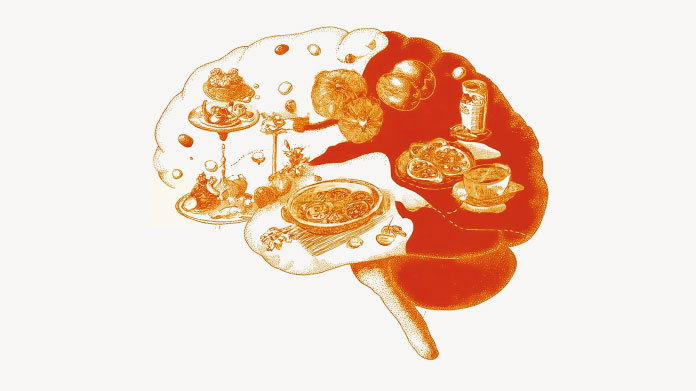What is lipolysis?
Lipolysis is the body’s mechanism for breaking down fats to make them absorbable and usable. There are two types: gastrointestinal lipolysis, which takes place during digestion, and adipocyte lipolysis, concerned with stored fat, which is often referred to as ‘fat-burning’. How can you use it to help achieve your slimming goals?

Digestive lipolysis, or breakdown of dietary fats
This form of lipolysis breaks down dietary fats, i.e., those we ingest when we eat food. The vast majority of these are triglycerides, complex lipids that are too large to be absorbed intact by the gut. They need to be made digestible when they pass into the intestine: from here, they are released into the bloodstream.
The digestion of dietary fats is initiated in the stomach by gastric lipase. Lipases are ‘fat-splitting’ enzymes. In the stomach, they emulsify triglycerides to produce smaller lipids (primarily monoglycerides and diglycerides).
The production of monoglycerides then triggers the synthesis of pancreatic lipase. This acts in the small intestine, breaking down 75% of the triglycerides ingested. It is also in the small intestine that biliary acids (contained in bile) come into play. Secreted by the liver and stored in biliary vesicles, these acids facilitate the digestion of large lipids by emulsifying them into small droplets. Once digested via this joint lipase/bile salt action, lipids are absorbed through the intestinal mucosa. Any excess dietary fats are stored in the form of triglycerides in adipocytes. This process is called strong>lipogenesis.
Under exercise conditions, adipocyte lipolysis eliminates fats stored in adipose tissue
Adipocytes are specialised fat-storing cells: they constitute the body’s principal store of available energy. Adipocyte clusters form adipose tissue which is found in different proportions and at different sites in the body depending on the individual. Men primarily have adipose tissue around the abdomen, while in most women, it is found on the thighs, buttocks, stomach and breasts. Excess fat produces a form of cellulite, responsible for the infamous ‘orange peel skin’.
Adipocyte lipolysis occurs when the body needs energy (during exercise or fasting...) and is unable to obtain it directly from the diet.
When this is the case, the body emits various hormone signals (adrenaline, noradrenaline, cortisol, ghrelin...), triggering a metabolic cascade that culminates in the mobilisation of... those same lipases! They break down the triglycerides present in adipocytes, releasing glycerol, fatty acids and... energy. The glycerol is predominantly eliminated by the kidneys. As for the fatty acids, they can either be broken down in the mitochondria of cells for energy production (beta-oxidation), or when present at excess levels, they can also be used to produce ketone bodies in the liver. These are a source of energy for the brain when there is insufficient glucose available. Prolonged fasting increases the production of ketone bodies, and in excess, they are toxic. It’s wise, therefore, to fast only under supervision.
How can you boost lipolysis to burn fat and aid weight loss?
To burn fat stored in adipose tissue in order to lose weight and slim down, you need to expend more energy. There are several natural and effective ways of doing this.
- Sustained physical activity is associated with increased production of adrenaline and noradrenaline which has the effect of mobilising the body’s reserves of glucose (glycogen in the muscles and liver) and fat (adipose triglycerides). The resulting hyperglycaemia and lipolysis provides energy that can be directly used by the body during exercise. What’s more, exercise conveniently produces a decrease in pancreatic hormone levels, to ensure steady blood sugar levels and energy provision. To maximise the mobilisation of fats, it’s important to prioritise regular, sustained exercise!
- Intermittent or periodic fasting is a gentler form of the more severe food restriction that can prove overly challenging. Intermittent fasting involves not eating for 16 hours. It is most often applied between (early) dinner and lunch, skipping breakfast, though alternatively, either of the day’s two main meals can equally be skipped. It’s thought this form of calorie restriction may activate a group of enzymes called sirtuins, which may have a positive effect on lipolysis.
- Some dietary supplements are also highly effective at activating lipolysis, particularly those containing green coffee (Green Coffee Extract) or moringa (Organic Moringa leaf extract).
So you now have a complete range of options for burning excess fat and achieving a trimmer figure!
References
- Carrière, Frédéric. (2013). La lipolyse gastro-intestinale chez l’homme. Lipid Nutri +.
- D. Langin. Mobilisation des triglycérides du tissu adipeux. Act. Méd. Int. - Métabolismes - Hormones - Nutrition, Volume VI, n° 2, mars-avril 2002.
- Activité physique et lipolyse adrénergique - Publications Inserm.
- Fernanda Reis de Azevedo, Dimas Ikeoka, Bruno Caramelli, Effects of intermittent fasting on metabolism in men, Revista da Associação Médica Brasileira, Volume 59, Issue 2, 2013, Pages 167-173.
Keywords
12 Days
A Product worth waiting for when not…
A Product worth waiting for when not available and then arriving as a surprise!
DOMINIC
14 Days
On time shipping
On time shipping
GEORGE Verne
15 Days
Ordering was easy and the product was…
Ordering was easy and the product was delivered with no problems. Appreciated that I was notified when it would arrive. Thanks!
MascarC
21 Days
Great customer service - responsive …
I ordered from them and my item was unavailable for sometime. I was super happy when they reactivated my order and shipped my item which arrived very quickly. Great customer service.
Ruth Rueter
22 Days
Super fast shipping
Super fast shipping
Donald Borling
25 Days
Reputable companysearch and the number of…
The research and the number of selection of products.
NAKHJAVAN Shervin
38 Days
The Anti Aromatase is a great product
The Anti Aromatase is a great product. You just need to have constant inventory. Recently this product has been out of stock.
GEORGE Verne
40 Days
Great help on chat
Great help on chat. Knowledgeable and friendly.
Jason Argos
43 Days
Customer service was fast and friendly.
Customer service helped to stop the transaction process of the subscription. I appreciated that.
Greenie
43 Days
I order here due to the high quality of…
I order here due to the high quality of the products and the quick delivery of items - thank you
Barbara J
45 Days
SuperSmart's Eye Pressure supplements: highly recommended!
I purchase SuperSmart's Eye Pressure supplements regularly for over 5 years, and gotta say they are truly a wonderful product for my Glaucoma. Highly recommended if you have eye pain from your Glaucoma.
D. Martinez
49 Days
Quick service
Quick service
MONELL
50 Days
Speedy service.
Speedy service.
ROSENTHAL Marvin
54 Days
Clear website- Efficient
Clear website. Excellent search engine and fast delivery!
Mohamad Hussein
56 Days
They have great products.
They have great products.
Vickie



